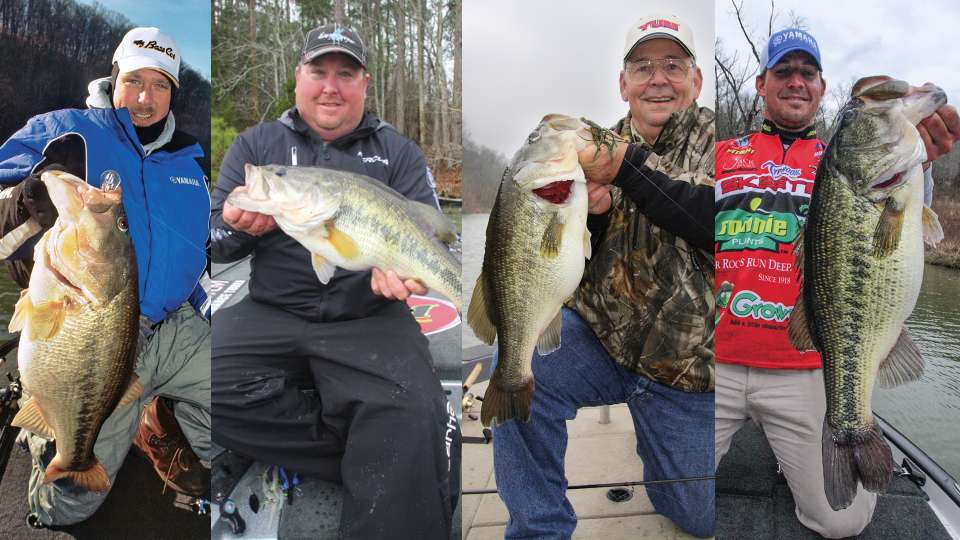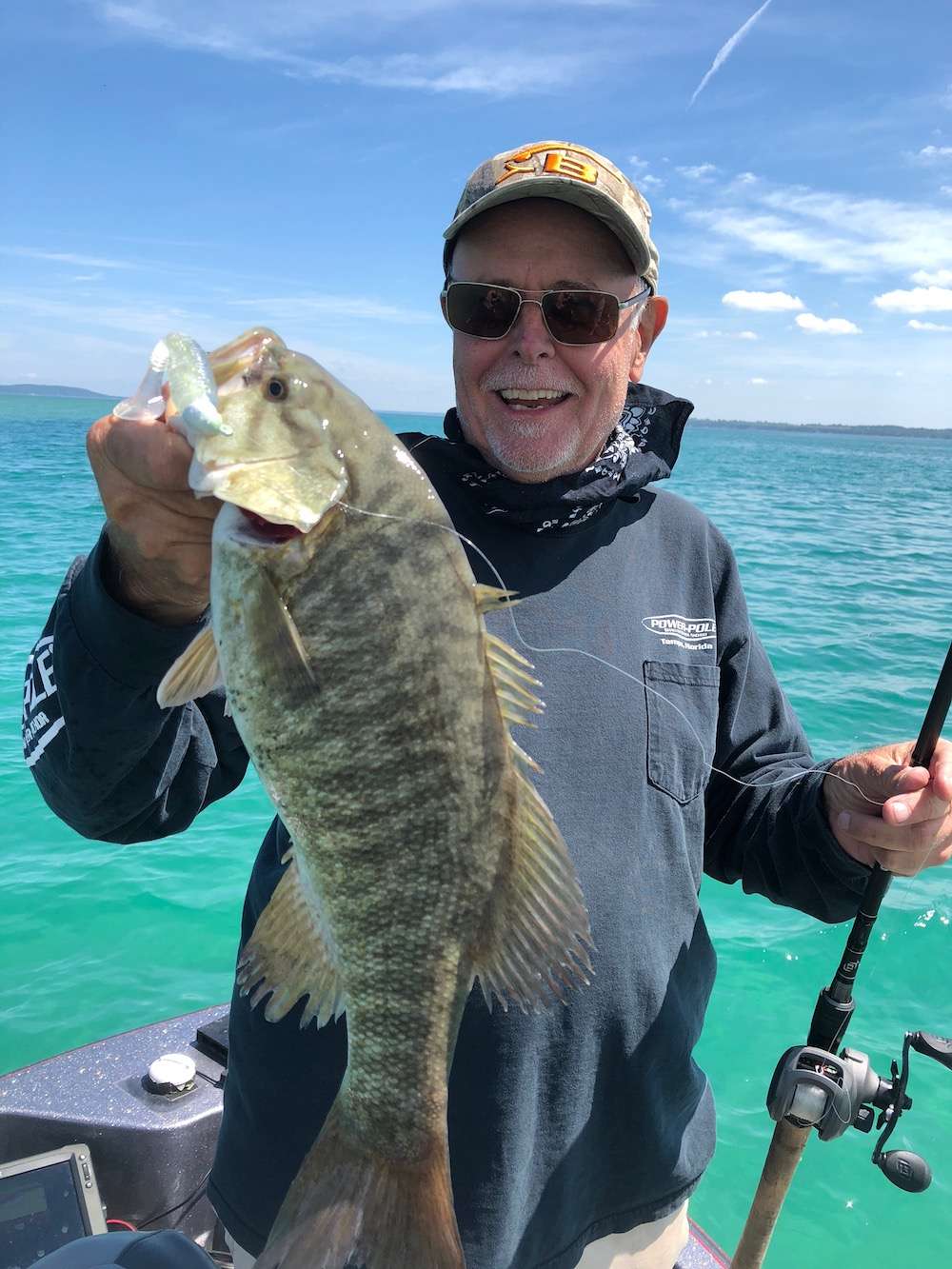
Let me make one thing clear: Russ Lane is not a wimp. The 6-foot, 3-inch veteran Bassmaster Elite Series angler was a standout athlete at Huntingdon College in his home state of Alabama and pitched for the Richmond Roosters minor league baseball team before becoming a professional angler. Today, when not on the road competing in B.A.S.S. tournaments, he stays in shape through low-impact cardiovascular workouts and rigorous weight training. Put simply, he’s one big, tough dude.
But on one frigid January morning back in 2007, Lane was shivering like a frightened bunny rabbit.
In the wake of a monster cold front, the air temperature was only 10 degrees when Lane arrived at the remote reservoir for his “Day on the Lake” outing for Bassmaster. The pro looked as puffed up as the Michelin Man after donning every piece of extreme-weather apparel he owned, yet he still worried aloud that the wind might blow through his multiple layers of clothing. Ice at the bottom of the boat ramp was so thick, it shattered the taillights and transom tie-downs on Lane’s trailer when he launched his bass rig.
The lake’s surface temp was barely 39 degrees, by far the coldest water Lane had ever fished. He realized ice extending several feet out from the bank around the reservoir’s perimeter would limit his presentation options. His fingers were frozen, and the unrelenting glare from the low winter sun was already giving him a crushing headache. “Why didn’t I schedule this article for June?” he groused. “I’ll be lucky if I get one or two bites all day.”
Lane’s prediction proved accurate. Seven hours of fishing in those brutally cold conditions did, in fact, result in very few bites. His tally for the day: only two bass. But it was a fishing trip he’ll never forget.
Lane’s first fish, a bug-eyed giant, weighed a staggering 11 pounds, 14 ounces. It still leads the “Day on the Lake” all-time lunker list and remains the biggest bass Lane has ever caught. His second fish weighed 6 pounds, 8 ounces — a fine specimen, even though Lane remarked that it looked like a minnow alongside his 11-14.
Two bass with a combined weight of 18 pounds, 6 ounces. If that doesn’t warm you up on a frigid winter day, nothing will!
As Lane proved in spades, you may not get many bites in winter, but your odds of catching some seriously big bass are high if you play your cards correctly. I asked Lane and other Elite Series anglers for some tips on scoring the big bite during the coldest weeks of the year. Heed their advice and you, too, could boat your bass of a lifetime this winter!
Lane’s lunker lesson

“Prior to my ‘Day on the Lake’ outing, 43-degree water was the coldest I’d ever fished, and my usual winter pattern had been pitching a jig to shallow cover,” Lane told Bassmaster. “But shoreline ice on the lake where we did the article covered hundreds of submerged logs, stumps and rocks, virtually eliminating this approach and forcing me to move offshore to fish deeper structure.”
Expecting bass to be very lethargic, Lane first tried probing flooded timber standing in 9 feet of water with a slow-sinking worm, but even this painstaking presentation failed to interest the fish. “Then, at 9:30 a.m., I located a 15-foot gut [ditch] running between the timber and a 30-foot channel on my graph and figured this might hold some bass,” he recalled. “I took out a cranking rod equipped with a slow-retrieve reel spooled with 10-pound fluorocarbon, tied on a deep-diving crankbait and caught the 11-14 on my first cast to the ditch. Twenty minutes later, after I’d calmed down enough to make my second cast, I caught the 6-8 from the same spot.”
Ditches are prime migration routes for winter bass, Lane explained. “Both bass and baitfish schools use ditches like underwater highways. They’re generally shallower than channels but deep enough for bass to retreat to during a winter frontal passage. If the day had been unseasonably warm and cloudy, the fish probably would have been either in the shallow part of the ditch or in the flooded timber. But with that massive cold front, they were sitting smack on the bottom of the deepest part of the structure. The combination of the fluorocarbon line [it sinks] and the long-billed plug enabled me to hit bottom with my presentations, which is when both of those big girls choked the lure. The lake where I caught those fish was clear, but if I’m fishing murky water in winter, I’ll crank shallower ditches and submerged rockpiles, especially those in the midsection of tributary arms near a well-defined channel break.”
Powroznik’s pointers

Ohio pro Jacob Powroznik also knows that frigid water can yield giant bass. During his early March 2015 “Day on the Lake” outing, he, like Lane, only managed to boat two keeper largemouth, but one of them was a monster weighing 9 pounds, 1 ounce. “I’d finished fifth in the 2015 Bassmaster Classic at Lake Hartwell [South Carolina] just prior to doing the ‘Day on the Lake’ article,” he recalled. “On one morning of Classic competition, the air temp was 10 degrees, yet I still found some clear, 48-degree water, experienced an active bite and caught a lot of fish. When I did the Bassmaster article two weeks later, I was a bit disheartened to find the surface temp of the small lake only in the low 40s. Plus, it had rained hard the night before, sending cold, muddy runoff pouring into the lake. And topping off the ‘trifecta of misery,’ the air temp had dropped 10 degrees in the first two hours of my fishing day! I knew the bite would be slow, so I made a conscious effort to maximize what few bites I might get by keying on the most likely places for big fish with proven lunker lures.”
Powroznik spent considerable time pounding riprap lining the small reservoir’s dam with crankbaits and jigs, both strong crawfish mimics. “In winter, big, lethargic bass will prowl rocky areas to gorge on slow-moving crawfish,” he reasoned. “Since the dam held the largest concentration of rocks of any place on the lake, I figured this should be a prime area to fish.” Powroznik failed to catch a single keeper off the dam, but his faith in his game plan remained unshaken. “I knew rock would be the key to big fish,” he said. “I just had to find it in another location.”
Around 10 a.m., Powroznik pulled up on a rocky main-lake ledge that dropped quickly from 9 to 18 feet. “On my first cast to the top of the ledge with a crankbait, I had a hellacious strike, but the fish pulled off,” he said. “Two casts later, I had another hard strike and boated my first keeper of the day, an awesome 9-pound, 1-ounce largemouth! I felt the crankbait tick the rocks, then the fish inhaled it the instant it swam into open water; she was evidently suspending right at the edge of the dropoff.” Powroznik caught just one other keeper that day, a 1-pounder, but he was totally stoked by catching the ‘picture fish’ you’ll see him holding in the 2016 Classic Preview edition of this publication. As he puts it, “Battling rain, wind, muddy water and plummeting air temperatures for seven hours with only two keepers to show for it may not sound like a fun day of bass fishing to most guys, but when one of those keepers weighs 9 pounds, you can bet it’s a day I’ll never forget!”
Poche’s 9-pounder

I’ve done “Day on the Lake” outings with other pros who managed to boat behemoth bass on harsh winter days by keying on high-opportunity targets with a few well-chosen lures. Here are some of their winning winter lunker strategies.
During his late February 2013 outing, a severe frontal passage marked by icy rain, gale-force winds and rapidly falling air temperature left Alabama pro Keith Poche struggling to catch anything other than a couple of scant keepers. Then Poche tied on an umbrella rig, slow rolled it across a main-lake point and whacked a 9-pound, 10-ounce monster. “If the water clarity is decent, an umbrella rig is arguably the best presentation you can use for a giant fish in the dead of winter,” he testifies. “We can’t use them in Elite Series competition, but you should try them on your home lake.”
Murray doubles up

Legendary Arkansas angler Bobby Murray, who won the very first B.A.S.S. tournament, bagged a hulking 10-1 largemouth off a steep channel bank during his bitterly cold, rainy February 2009 outing. “The fish was sitting right where the steep bank transitioned into a gravel flat,” he noted. Murray also caught a 7-pounder off a lone stump on a submerged ridge.
Unexpected Winter Lunker Hot Spots
If your usual winter bass spots aren’t paying off, follow the advice of these Bassmaster Elite Series pros and check out some fresh locations on your home lake. You just might get your string stretched big time.
Catchin’ rays — “Big bass may move into a foot of water to warm themselves on calm, sunny, winter days,” swears Michigan pro Chad Pipkens. “Once the sun gets high, back off the shoreline and retrieve a lipless crankbait slowly around shallow rocks; they heat up quickly on sunny days.”
Bass saunas — “I’ve seen baitfish and bass stack up during winter where an underground spring gushes into the lake,” says Alabamian Justin Lucas. “Spring water generally runs in the 52-degree range year-round, which may be 10 degrees warmer than lake water in winter. Springs are especially common in highland reservoirs with extensive porous limestone rock. Monitor your graph’s temperature readout while you’re idling around, looking for baitfish and structure; if it starts rising rapidly, you’re probably near a spring. If baitfish and bass are deep, try a jigging spoon. If they’re shallower, a small shad-imitating crankbait should work.”
Crappie cover — “Murky flatland reservoirs can be prime crappie venues, and local anglers often sink brushpiles to attract these fish,” says Michigan pro Jonathon VanDam. “During winter, when most crappie fans aren’t fishing, I’ll use my graph’s side-imaging function to pinpoint isolated crappie attractors in the 7- to 12-foot zone, then probe them with a jig or shaky head worm. This is an awesome lunker tactic on those cold, dreary winter days where the water is too muddy to use a jerkbait or swimbait.”
Originally published in 2016.





